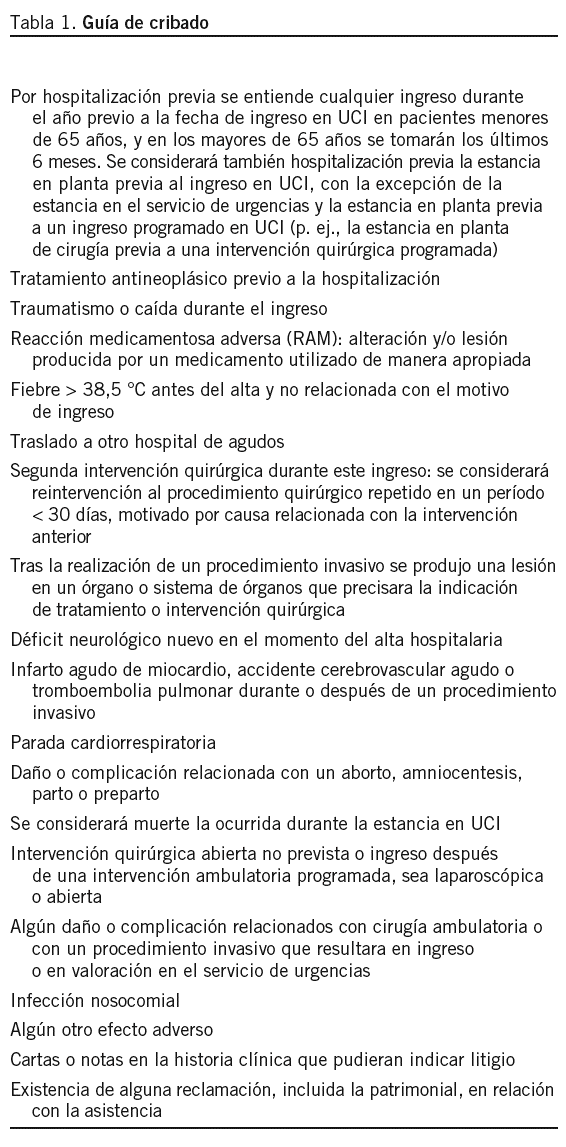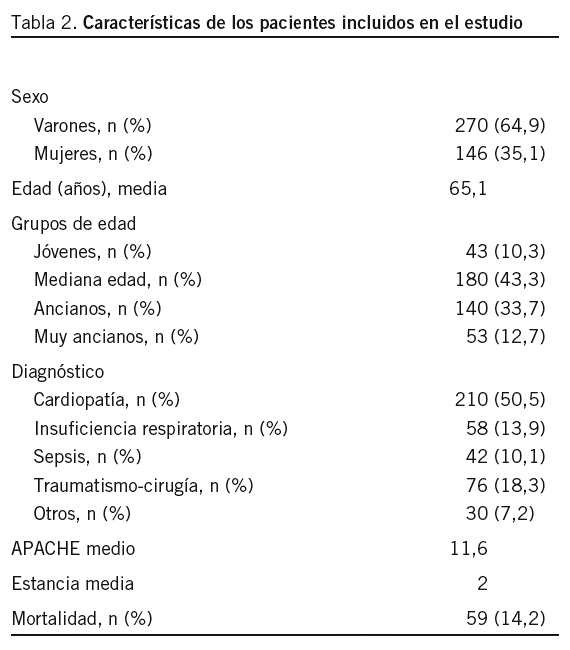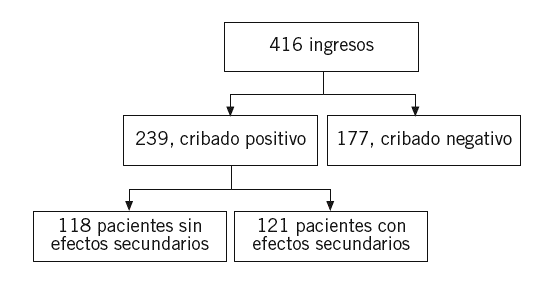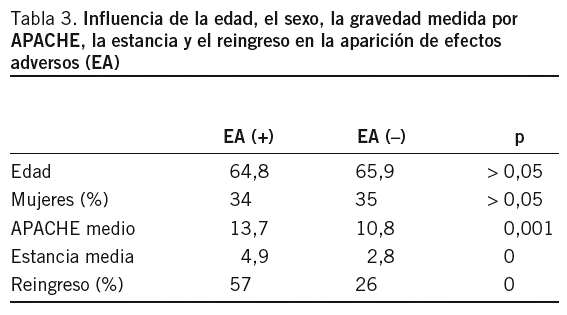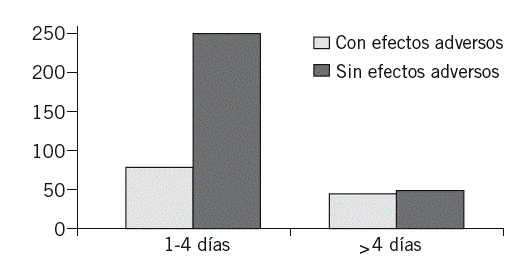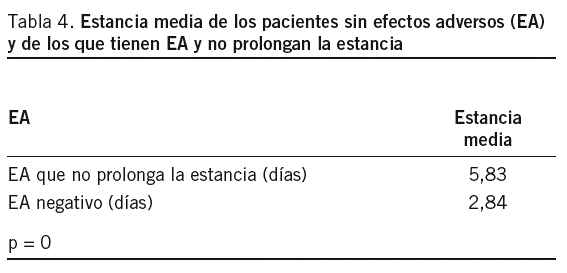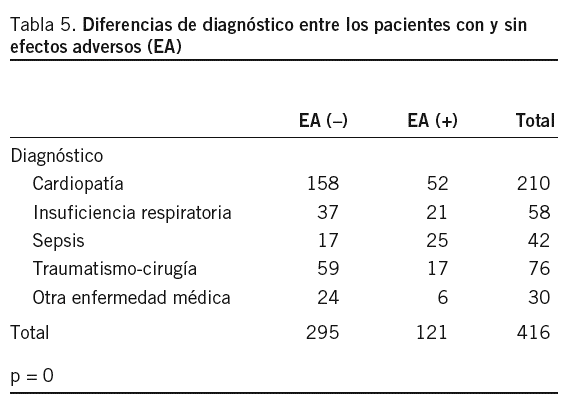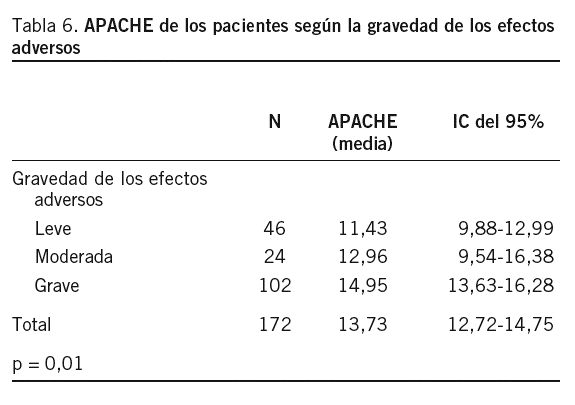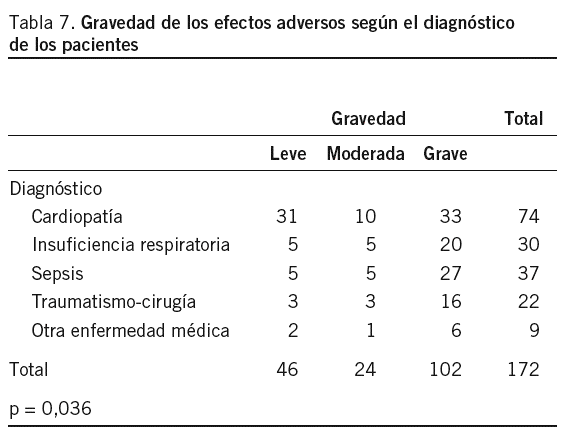Información de la revista
Vol. 22. Núm. 6.
Páginas 277-286 (Noviembre 2007)
Vol. 22. Núm. 6.
Páginas 277-286 (Noviembre 2007)
Acceso a texto completo
Incidencia de efectos adversos en una unidad de medicina intensiva
Incidence of adverse events in an intensive care unit
Visitas
4835
Isabel Gutiérrez Cíaa, Carlos Aibar Remónb, Asunción Beamonte San Agustínc, Blanca Obón Azuaraa, Carlos Sánchez Polod, Diego Júdez Legaristib
a Servicio de Medicina Intensiva. Hospital Clínico Universitario Lozano Blesa. Zaragoza. España.
b Servicio de Medicina Preventiva y Salud Pública. Hospital Clínico Universitario Lozano Blesa. Zaragoza. España.
c Escuela Universitaria de Estudios Empresariales. Zaragoza. España.
d Unidad de Medicina Intensiva. Hospital Obispo Polanco. Teruel. España.
Este artículo ha recibido
Información del artículo
Objetivos: Los pacientes críticos tienen un riesgo especialmente alto de presentar efectos adversos (EA). En este trabajo estudiamos la incidencia de EA en una unidad de cuidados intensivos (UCI) para identificar los factores que incrementan el riesgo de presentarlos, los clasificamos según su gravedad y medimos su influencia en la estancia en UCI. Material y método: Estudio prospectivo de cohortes realizado en los pacientes ingresados en una UCI de un hospital pequeño en 1 año. La revisión se llevó a cabo en dos fases: primero se utilizó una guía de cribado y en segundo lugar se revisaron las historias seleccionadas mediante un cuestionario de confirmación para identificar los EA. Se analizó la influencia de la edad, el sexo, el diagnóstico, la puntuación APACHE y la estancia en la aparición de EA. Se determinó la repercusión de los EA en la estancia del paciente en la unidad. Se clasificaron los EA en tres grupos: graves, moderados y leves. Resultados: Se revisaron 416 historias clínicas y la guía de cribado seleccionó 259. El 29% de los pacientes (121) presentaron 172 EA. La edad y el sexo no demostraron influencia. Los pacientes con estancias prolongadas presentaron EA con mayor frecu encia (49%) que los que tuvieron estancias cortas (24%). La puntuación APACHE fue más elevada en los pacientes que presentaron EA. El grupo diagnóstico que con mayor frecuencia presentó EA fue el de pacientes sépticos. Ocurrieron un 59,3% de EA graves, un 14% de EA moderados y un 26,7% de EA leves. Los EA motivaron 323 estancias, es decir, el 22,5% del total de las estancias en UCI. Conclusiones: Los EA son frecuentes entre los pacientes críticos. La mayor gravedad y la estancia prolongada incrementaron el riesgo de EA. Los EA fueron graves y prolongaron la estancia de los pacientes en la UCI.
Palabras clave:
Efectos adversos
Seguridad
Evaluación del riesgo
Objectives: Critically ill patients have an especially high risk of adverse events (AE). We sought to study the incidence of AE in an intensive care unit (ICU) to identify which factors could increase the risk of AE, determine their severity, and evaluate their influence on length of stay. Material and method: We performed a prospective 1-year cohort study in patients admitted to the ICU of a small hospital. The study was carried out in two phases: in the first phase, a screening guide was used and in the second phase, positively screened records were reviewed to identify AEs. The influence of age, sex, diagnosis, APACHE score and length of stay on the occurrence of AE were analyzed and the effect of these events on the patient's length of stay in the unit was determined. AE were classified in three groups: serious, moderate and minor. Results: We reviewed 416 records and screened 259. One hundred twenty-one (29%) patients had 172 AE. Age and sex had no influence. AE were more frequent in patients with longer stays (49%) than in those with shorter stays (24%). The APACHE score was higher in patients with AE. The most frequent diagnosis in the AE group was sepsis. A total of 59.3% AE were serious, 14% were moderate and 26.7% were minor. AE prolonged ICU stay by 323 patient-days, representing 22.5% of ICU time. Conclusions: AE were frequent in critically ill patients. Greater severity and prolonged stay increased the risk of AE. AE were serious and prolonged ICU stay.
Keywords:
Adverse events
Safety
Risk assessment
El Texto completo está disponible en PDF
Bibliografía
[1]
Gomez Rubí J..
Origen de la Medicina Intensiva en España: historia de una revolución..
Med Intensiva, 22 (1998), pp. 421-8
[2]
Infection and error called special hazards of intensive care units..
Mod Hosp, 107 (1966), pp. 98
[3]
Pronovost P, Wu AW, Dorman T, Morlock L..
Building safety into ICU..
J Crit Care, 17 (2002), pp. 78-85
[4]
Cullen DJ, Sweitzer BJ, Bates DW, et al..
Preventable adverse drug events in hospitalized patients: a comparative study of intensive care and general care units..
Crit Care Med, 25 (1997), pp. 1289-97
[5]
Barr D..
Hazards of modern diagnosis and Therapy the price we pay..
JAMA, 159 (1955), pp. 1452
[6]
Moser R..
Diseases of medical progress..
N Engl J Med, 255 (1956), pp. 606
[7]
Brennan TA, Leape LL, Laird NM, Hebert L, Localio AR, Lawthers AG, et al..
Incidence of adverse events and negligence in hospitalized patients. Results of the Harvard Medical Practice Study I..
N Engl J Med, 324 (1991), pp. 370-6
[8]
Leape L..
Brennan T, Laird N, Lawthers AG, Localio AR, Barnes BA, et al. The nature of adverse events in hospitalized patients: Results of the Harvard medical Practice Study II..
N Engl J Med, 324 (1991), pp. 377-84
[9]
Localio AR, Lawthers AG, Brennan TA, Laird NM, Herbert LE, Peterson LM, et al..
Relation between malpractice claims and adverse events due to negligence. Results of the Harvard Medical Practice Study III..
N Engl J Med, 325 (1991), pp. 245-51
[10]
Thomas EJ, Studdert DM, Burstin HR, Orav EJ, Zeena T, Williams EJ, et al..
Incidence and types of adverse events and negligent care in Utah and Colorado..
Med Care, 38 (2000), pp. 261-71
[11]
Wilson RM, Runciman WB, Gibberd RW, Harrisson BT, Newby l, Hamilton JD..
The quality in Australian health-care study..
Med J Aust, 163 (1995), pp. 458-71
[12]
Vicent C, Neale G, Woloshynowych M..
Adverse events in British hospitals: preliminary retrospective record review..
BMJ, 322 (2001), pp. 517-9
[13]
Schioler T, Lipckzak H, Pedersen B, et al..
Incidence of adverse events in hospitals. A retrospective study of medical records..
Ugeskr Laeger, 163 (2001), pp. 5370-8
[14]
Davis P, Lay Yee R, Briant R, Scott A, Schug S..
Adverse events in New Zealand public hospitals I: occurrence and impact..
N Z Med J, 115 (2002), pp. 271-8
[15]
Davis P, Lay Yee R, Briant R, Ali W, Scott A, Schug S..
Adverse events in New Zealand public hospitals II: preventability and clinical context..
N Z Med J, 116 (2003), pp. 624-30
[16]
Baker GR, Norton PG, Flintoft V, Blais R, Brown A, Cox J, et al..
The Canadian Adverse Events Study: the incidence of adverse events among hospital patients in Canada..
CMAJ, 170 (2004), pp. 1678-86
[17]
Abramson NS, Wald KS, Grenvik AN.A, Robinson D, Zinder JV..
Adverse ocurrences in intensive Care Units..
JAMA, 244 (1980), pp. 1582-4
[18]
Wu AW, Pronovost P, Morlock L..
ICU Incident Reporting Systems..
J Crit Care, 17 (2002), pp. 86-94
[19]
Beckmann U, West IF, Groombridge GJ, Baldwin I, Hart GK, Clayton DG, et al..
The development and evaluation of an incident reporting system in intensive care..
Anaesth Intensive Care, 3 (1996), pp. 314-9
[20]
Aranaz JM, Aibar C, Gea MT, Leon MT..
Efectos adversos en la asistencia hospitalaria. Una revisión crítica..
Med Clin (Barc), 123 (2004), pp. 21-5
[21]
Thommas EJ, Petersen LA..
Measuring errors and adverse events in health care. J Gen Intern Me, 18 (2003), pp. 61-7
[22]
Wright D, Mackenzie SJ, Buchan I, Cairos Cs, Price LE..
Critical incidents in the intensive therapy unit..
Lancet, 338 (1991), pp. 676-8
[23]
Hart GK, Baldwin I, Gutteridge G Foros J..
Adverse Incident reporting in intensive care..
Anaesth Intens Care, 22 (1994), pp. 556-1
[24]
Flaate.n, Ebrio O..
Errors in the intensive care unit: experiences with an anonymous registration..
Acta Anaesthesiol Scand, 43 (1999), pp. 614-7
[25]
Buckley TA, Short TG, Rowbottom YM..
Critical incident reporting in the intensive care unit..
Anaesthesia, 52 (1997), pp. 403-9
[26]
Osmon S, Harris CD, Dunagan WC, Prentice D, Fraser VJ, Kollef MH..
Reporting of medical errors: an intensive care experience..
Crit Care Med, 32 (2004), pp. 727-33
[27]
Graf J, Von den Driesch A, Koch KC, Janssens U..
Identification and characterization of errors and incidents in a medical intensive care unit..
Acta Anaesthesiol Scand, 49 (2005), pp. 930-40
[28]
Giraud T, Dhainaut JF, Vaxelaire JF, et al..
Iatrogenic complications in adult intensive care units. A prospective two-centres study..
Crit Care Med, 21 (1993), pp. 40-51
[29]
Andrews LB, Stocking C, Krizet T, Gottlieb L..
An alternative strategy for studying adverse events in medical care..
Lancet, 349 (1997), pp. 309-5
[30]
Bracco D, Favre JB, Bissonnette B, et al..
Human errors in a multidisciplinary intensive care unit: a 1-year prospective study..
Intensive Care Med, 1 (2001), pp. 137-45
[31]
Bellomo R, Goldsith D, Russell S, Uchino S..
Postoperative serious adverse events in a teaching hospital: a prospective study..
MJA, 176 (2002), pp. 216-8
[32]
Capuzzo M, Nawfal I, Campi M, Valpondi V, Verri M, Alvisi R..
Reporting of unintending events in an intensive care unit: comparison between staff and observer..
BMC Emerg Med, 5 (2005), pp. 1-79
[33]
Valentin A, Capuzzo M, Guidet B, et al..
Patient safety in intensive care: results from the multinational Sentinel Events Evaluation (SEE) study..
Intensive Care Med, 32 (2006), pp. 1591-8
[34]
Donchin Y, Gopher D, Olin M, et al..
A look into the nature and causes of human errors in the intensive care unit..
Crit Care Med, 23 (1995), pp. 294-300
[35]
Results from Luther Midelfort [citado May 2005]. Disponible en: http://www.QualityHealthCare.org.
[36]
Beckmann U, Bohringer C, Carless R, et al..
Evaluation of two methods for quality improvement in intensive care: Facilitated incident monitoring and retrospective chart review..
Crit Care Med, 31 (2003), pp. 1006-11
[37]
Rostchild JM, landrigan CP, Cronin JW, et al..
The Critical Care Safety Study: the incidente and nature of adverse events and serious medical errors in intensive care..
Crit Care Med, 33 (2005), pp. 1694-700
[38]
Beckmann U, Baldwin I, Hart GK..
The Australian Incident Monitoring Study in Intensive Care: AIMS-ICU. An analysis of the first year of reporting..
Anaesth Intensive Care, 3 (1996), pp. 320-9
[39]
Durie M, Beckmann U, Gillies DM..
Incidents relating to arterial cannulation as identified in 7,525 reports submitted to the Australian Incident Monitoring Study (AIMS-ICU)..
Anaesth Intensive Care, 1 (2002), pp. 60-5
[40]
Beckmann U, Gillies DM, Berenholtz Sm, Wu A, Pronovost P..
Incidents relating to the intra-hospital transfer of critically ill patients. An analysis of the reports submitted to the Australian Incident Monitoring Study in Intensive Care..
Intensive Care Med, 8 (2004), pp. 1579-85
[41]
Beckmann U, Baldwin I, Durie M, Morrison A, Shaw L..
Problems associated with nursing staff shortage: an analysis of the first 3600 incident reports submitted to the Australian Incident Monitoring Study (AIMS-ICU)..
Anaesth Intensive Care, 4 (1998), pp. 396-400
[42]
Abizanda R..
Editorial sobre la especialidad de Medicina Intensiva. Atención especializada al paciente crítico. Una contribución a la perspectiva sobre la especialidad en medicina intensiva..
Med Intensiva, 27 (2003), pp. 541-3
[43]
Notes on intensive care medicine system in Europe. En Organisation and manegement on intensive care. Berlin, Heidelberg, New York: Springer Verlag; 1998. p. 86-113.
[44]
Pronovost PJ, Angus DC, Dorman T, Robinson KA, Dremsizov TT, Young TL..
Physician staffing patterns and clinical outcomes in critically ill patients: A systematic review..
JAMA, 288 (2002), pp. 2151-62
[45]
Aranaz JM, Gea MT, Marín G..
Acontecimientos adversos en un servicio de cirugía general y de aparato digestivo de un hospital universitario..
Cir Esp, 73 (2003), pp. 104-9
[46]
Knaus WA, Zimmerman JE, Wagner DP, Draper EA, Lawrence DE..
APACHE- acute phisiology and chronic health evaluation: a physiologically based classification system..
Crit Care Med, 9 (1981), pp. 591-7
[47]
Estudio Nacional sobre los Efectos Adversos ligados a la hospitalización. Madrid: ENEAS; 2005.
[48]
Álvarez-Lerma F, Palomar M, Olaechea P, De la Cal M, Insausti J, Bermejo B, et al..
Estudio Nacional de Vigilancia de la Infección Nosocomial en Unidades de Cuidados Intensivos. Informe del año 2000..
Med Intensiva, 26 (2002), pp. 39-50
[49]
Vigilancia y control de infecciones en las unidades de cuidados intensivos: Tasas, resistencias y estado de portador. Enferm Infecc Microbiol Clin. 1997;15 Supl 3:47-52.
[50]
Craven DE, Driks MR..
Nosocomial pneumonia in the intubated patient..
Semin Respir Infect, 2 (1987), pp. 20-33
[51]
Vincent JL, Bihari DJ, Suter PM, Bruining HA, White J, Nicolas-Chanoin MH..
The prevalence of nosocomial infection in intensive care units in Europe. Results of the European Prevalence of Infection in Intensive Care (EPIC) Study. EPIC International Advisory Committee..
JAMA, 274 (1995), pp. 639-44
[52]
Spanish Study Group of Surveillance of ICU-Acquired Infection. Surveillance of ICU-acquired infection. Time trends of indicators of ICU-acquired infections from 1994-1997. A Spanish multicenter study. Intensive Care Med. 1998;24 Suppl 1:S57.
[53]
Vigilancia y control de la neumonía asociada a ventilación mecánica [citado 2 Abr 2007]. Disponible en: www.cfnavarra.es/ salud/anales/textos/vol23/suple2/suple13a.htlm
[54]
Disponible en: www.semicyuc.org
[55]
Disponible en: www.semicyuc.org
[56]
Estat actual dels serveis de Medicina Intensiva a Catalunya [tesis doctoral]. Barcelona: Universitat Autónoma de Barcelona; 1995.
[57]
Estudio multicéntrico
[58]
Vázquez G, Jiménez Quintana MM, Rivera R, et al..
Objetivación de la gravedad mediante el sistema APACHE III aplicado en España..
Med Clin (Barc), 117 (2001), pp. 446-51
[59]
Obón Azuara B, Gutiérrez Cía I, Sanchez Polo CM..
Idoneidad de los ingresos de los pacientes muy ancianos en las unidades de cuidados intensivos..
Rev Esp Geriatr Gerontol, 41 (2006), pp. 193-5
[60]
¿Son los pacientes ancianos un tipo diferente de paciente en la Medicina Crítica? XXXX Congreso S. Española de M. Intensiva, Críticos y U. Coronarias (SEMICYUC). La Coruña, junio de 2005. [citado 2 Abr 2007] Disponible en: www.semicyuc.org
[61]
López Messa JB..
Envejecimiento y Medicina Intensiva..
Med Intensiva, 29 (2005), pp. 469-74
[62]
García Lizana F, Manzano Alonso JL, Saavedra Santana P..
Mortalidad y calidad de vida al año del alta de una unidad de cuidados intensivos en pacientes mayores de 65 años..
Med Clin (Barc), 116 (2001), pp. 521-5
[63]
Esteban A, Lázaro A..
El anciano y la unidad de cuidados intensivos..
Rev Esp Geriatr Gerontol, 22 (1987), pp. 195-7
[64]
Groeger JS, Guntupall.i, KK, Strosberg M, Halpern N, Raphaely RC, et al..
Descriptive analysis of critical care units in the United Status: patient characteristics and intensive care unit utilization..
Crit Care Med, 21 (1993), pp. 279-91
[65]
Reis Miranda D..
El impacto de la organización sobre la calidad de la medicina intensiva. Presentación de un estudio europeo. EURICUS-I..
Rev Calidad Asistencial, 11 (1996), pp. S74-9
[66]
Ludwigs U, Hulting J..
Acute physiology and chronic evaluation II scoring system in acute myocardial infarction: a prospective validation study..
Crit Care Med, 23 (1995), pp. 854-9
[67]
Abizanda P, Balerdi B, López J, et al..
Fallos de predicción de resultados mediante APACHE II. Análisis de los errores de predicción de mortalidad en pacientes críticos..
Med Clin (Barc), 102 (1994), pp. 527-31
[68]
Studdert DM, Thomas EJ, Burstin HR, et al..
Negligent care and malpractice claiming behaviour in Utah and Colorado..
Med Care, 38 (2000), pp. 250-60
[69]
Bates DW, Cullen DJ, Laird N..
Incidence of adverse drug events and potencial adverse drug events. Implication for prevention. ADE Prevention Study Group..
JAMA, 274 (1995), pp. 29-34
[70]
Foster AJ, Asmis TR, Clark HD, et al..
Ottawa hospital patient Safety Study: incidente and timing of adverse events in patients admitted to a Canadian teaching hospital..
CMAJ, 8 (2004), pp. 1235-40
[71]
Zhan C, Miller MR..
Excess lenght of stay, charles and mortality attributable to medical injuries during hospitalization..
JAMA, 290 (2003), pp. 1868-74
[72]
Morrison AL, Beckmann U, Durie M, Carless R, Gillies DM..
The effects of nursing staff inexperience (NSI) on the occurrence of adverse patient experiences in ICUs..
Aust Crit Care, 3 (2001), pp. 116-21
[73]
Needham DM, Thompson DA, Holzmueller CG, Dorman T, Lubomski LH, Wu AW, et al..
A system factor analysis of airway events from the intensive care Unit Reporting System..
Crit Care Med, 32 (2004), pp. 2227-33
[74]
Disponible en: www.semicyuc.org





